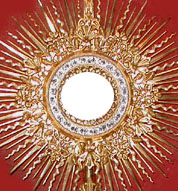Answered by Legionary of Christ Father Edward McNamara, professor of liturgy and dean of theology at the Regina Apostolorum university.
Q: Your article «Vestments for Exposition and Benediction» helped me a lot. I was interested in the possibility of using different liturgical colors during adoration. Is there a liturgical document that says that it is OK to use a green cope and humeral veil, during Eucharistic adoration outside of Mass, while praying Sunday Evening Prayer II of Ordinary time? Or violet during Lent and so on? — E.C., Orange, New Jersey
A: The original reply from April 25, 2017, already hinted at this possibility when we mentioned that, while the usual norm was white vestments, the norms themselves imply possible exceptions with respect to exposition. For example, when exposition is during Mass the priest would expose wearing the chasuble and stole of the corresponding day. Since this form of exposition is not tied to particular feasts, the exposition could use any liturgical color.
We continued:
“The above would be the most common exception. Another would be if solemn vespers are celebrated at the conclusion of a prolonged period of adoration. In this case, the celebrant could wear a stole and cope of the proper liturgical color of the office and then give the Benediction using a white humeral veil. Otherwise, he could wear white for the hour of the Divine Office.
«Due to these exceptions, we cannot say that the rule that white is always the required color is a strict rule. However, the exceptions are always in the context of another liturgical act being in some way combined with exposition or Benediction.
«In the case mentioned by our reader, if solemn lauds or vespers were to immediately follow exposition, then it could be an option to expose in a cope of a different color than white.
«If this is not the case, then it would not be correct to use stoles or copes of any color other than white for the moment of exposition and Benediction.”
To further clarify this reply we could say that when a liturgical act such as the Liturgy of the Hours is carried out before the Blessed Sacrament exposed it would usually follow its normal rubrics except in such aspects as directly relate to the veneration of the Blessed Sacrament.
Thus, for example, if solemn lauds or vespers are prayed within the context of a prolonged exposition, which will continue after the celebration of the office, then the priest would wear stole and cope of the proper liturgical color (green, white, red or violet).
The celebrant’s chair is usually placed at an angle in such a way that he is turned toward the Blessed Sacrament, without necessarily facing away from the people.
If the altar is to be incensed during the Benedictus or Magnificat, then, having prepared the thurible at the chair, the celebrant and ministers would come to the front of the altar, genuflect and kneel while the celebrant incenses the Blessed Sacrament in the usual manner. They would then go up to the altar, genuflect again and continue the incensing the altar. They would also genuflect together whenever they pass the monstrance.
If desired, the concluding intercessions of the office may be made, as the celebrant and ministers stand before the altar with the monstrance.
The final blessing and dismissal are omitted.
The priest and ministers then genuflect and withdraw.
With respect to humeral veils, as mentioned in the previous article, there is some tradition for using red or violet humeral veils to transfer the Blessed Sacrament during the services of Holy Week.
When it comes to imparting Benediction, however, as far as I know, the custom is that the humeral veil should always be white, even if the cope is of a different liturgical color.
* * *
Readers may send questions to zenit.liturgy@gmail.com. Please put the word «Liturgy» in the subject field. The text should include your initials, your city, and your state, province or country. Father McNamara can only answer a small selection of the great number of questions that arrive.

Wikimedia Commons
Liturgy Q & A: Colored Vestments During Exposition and Benediction
Variations Allowed at Certain Moments


